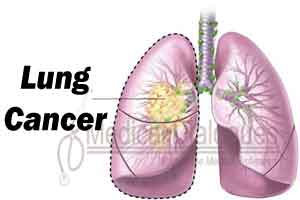- Home
- Editorial
- News
- Practice Guidelines
- Anesthesiology Guidelines
- Cancer Guidelines
- Cardiac Sciences Guidelines
- Critical Care Guidelines
- Dentistry Guidelines
- Dermatology Guidelines
- Diabetes and Endo Guidelines
- Diagnostics Guidelines
- ENT Guidelines
- Featured Practice Guidelines
- Gastroenterology Guidelines
- Geriatrics Guidelines
- Medicine Guidelines
- Nephrology Guidelines
- Neurosciences Guidelines
- Obs and Gynae Guidelines
- Ophthalmology Guidelines
- Orthopaedics Guidelines
- Paediatrics Guidelines
- Psychiatry Guidelines
- Pulmonology Guidelines
- Radiology Guidelines
- Surgery Guidelines
- Urology Guidelines
CT screening significantly reduces deaths from lung cancer

The use of computed tomography (CT) screening among asymptomatic men at high risk for lung cancer reduced lung cancer mortality by 26% and by as much as 61% in women, demonstrate findings from a large randomized European study called NELSON.
Results of the study were presented at the International Association for the Study of Lung Cancer (IASLC) 19th World Conference on Lung Cancer (WCLC 2018) by Harry J. De Koning, Erasmus MC, Rotterdam, Netherlands.
NELSON study was a population-based, controlled trial that enrolled 15,792 individuals, who were randomized 1:1 to either the study arm or control arm. Study arm participants were offered CT screenings at baseline, one, three and five and one-half years after randomization. No screenings were offered to control arm participants. Participants’ records were linked to national registries with 100 percent coverage regarding cancer diagnosis (Netherlands Cancer Registry), date of death (Centre for Genealogy) and cause of death (Statistics Netherlands). An expert panel reviewed 65 percent of cases. The follow-up period comprised a minimum of 10 years, unless deceased, for 93.7 percent of enrolled participants.
Also Read: A new type of lung cancer discovered by Researchers
Key Findings:
- The results of the study showed an 86 percent average CT screening compliance rate, encompassing 29,736 scans.
- In 9.3 percent of participants, additional CT scans were performed within two months to estimate nodule volume doubling time, leading to an overall referral rate of 2.3 percent for suspicious nodules.
- Detection rates across the rounds varied between 0.8 and 1.1 percent, and 69 percent of screen-detected lung cancers were detected at Stage 1A or 1B.
- A total of 261 lung cancers (52 interval cancers) were detected before the fourth round of follow-ups.
- In a subset of analyzed patients, surgical treatment was three times significantly more prevalent in study lung cancer patients than in control arm patients (67.7 percent versus 24.5 percent, p<0.001).
- At 8-year and 9-year follow-up, men who underwent screening had a 25 percent (95 percent CI, 0.59 to 0.95; p=0.015) and 24 percent (95 percent CI, 0.60 to 0.95; p=0.012) reduction in risk of lung cancer mortality, respectively.
“Strikingly, women who underwent screening had a 61 percent [95 percent CI, 0.18 to 0.78; p=0.0037] reduction in risk of lung cancer mortality at 8 years and a 53 percent [95 percent CI, 0.25 to 0.84; p=0.0069] risk reduction at 9 years,” reported Dr. De Koning.
“More than 80 percent of participants in each arm were men. About 55 percent were current smokers, and the median tobacco exposure was almost 40 pack-years,” said de Koning.
The overall screening uptake rate was 85.6 percent. A positive result was reported in 2.2 percent of the participants, while 9.3 percent had an indeterminate result and underwent further CT scans 3–4 months after the initial scans.
“The lung cancer detection rate was 0.9 percent, with a positive predictive value for a positive test result of 41 percent,” said de Koning. “In the screening arm, lung cancer cases were mainly in stage I, with just over 10 percent of the cases being in stage IV. In contrast, about half of the cases in the control arm were in stage IV.”
“Among male participants, there were 214 lung cancer deaths in the control arm and 157 lung cancer deaths in the screening arm. A clear difference was observed as early as in years 2–3,” he noted.
These findings show that CT screenings are an effective way to assess lung nodules in people at high risk for lung cancer, often leading to detection of suspicious nodules and subsequent surgical intervention at relatively low rates and with few false positives, and can positively increase the chances of cure in this devastating disease,” Dr. De Koning concluded. “It is the second largest trial in the world, with an even more favorable outcome than the first trial, the NLST, showed. These results should be used to inform and direct future CT screening in the world.

Disclaimer: This site is primarily intended for healthcare professionals. Any content/information on this website does not replace the advice of medical and/or health professionals and should not be construed as medical/diagnostic advice/endorsement or prescription. Use of this site is subject to our terms of use, privacy policy, advertisement policy. © 2020 Minerva Medical Treatment Pvt Ltd